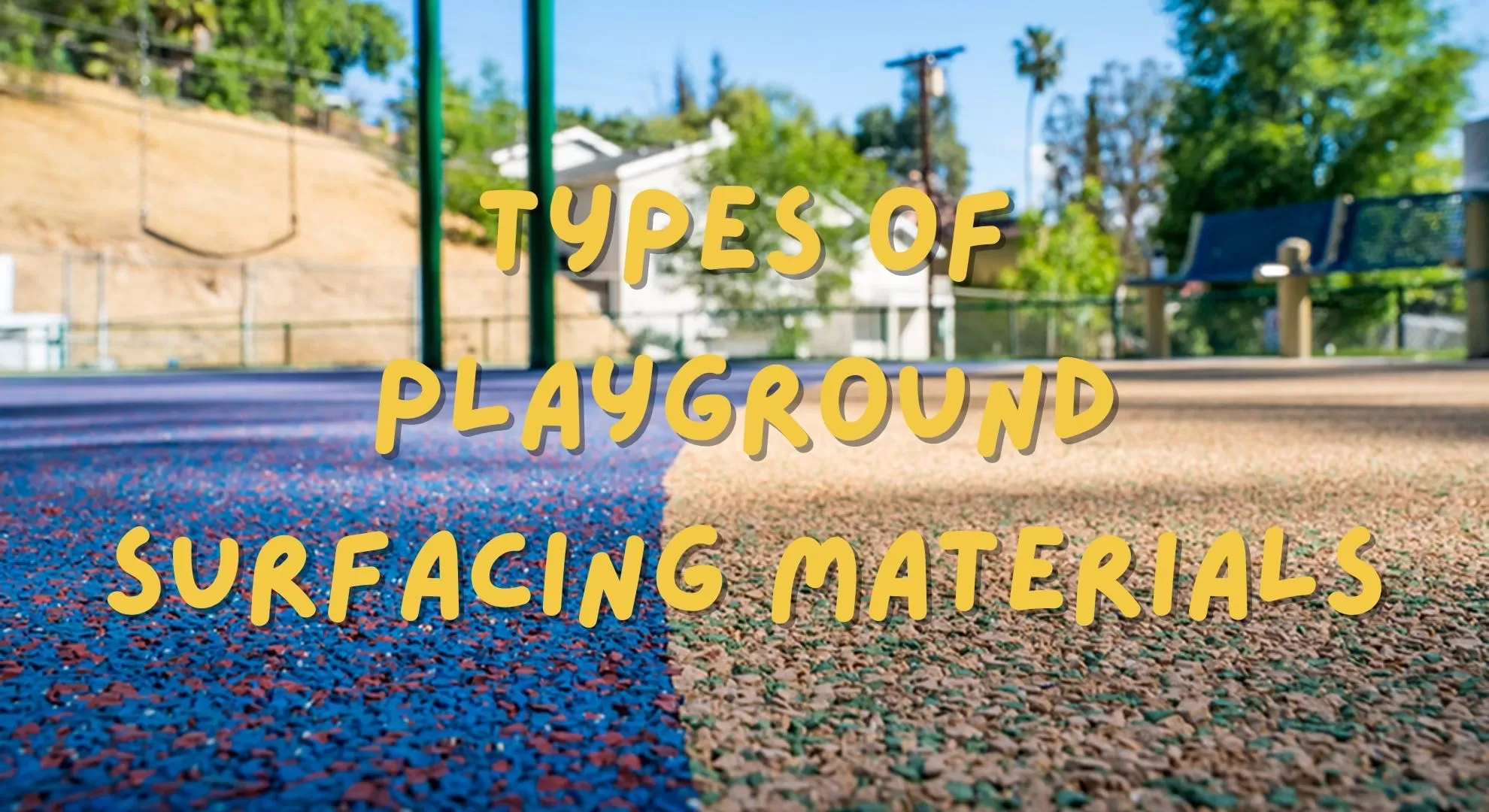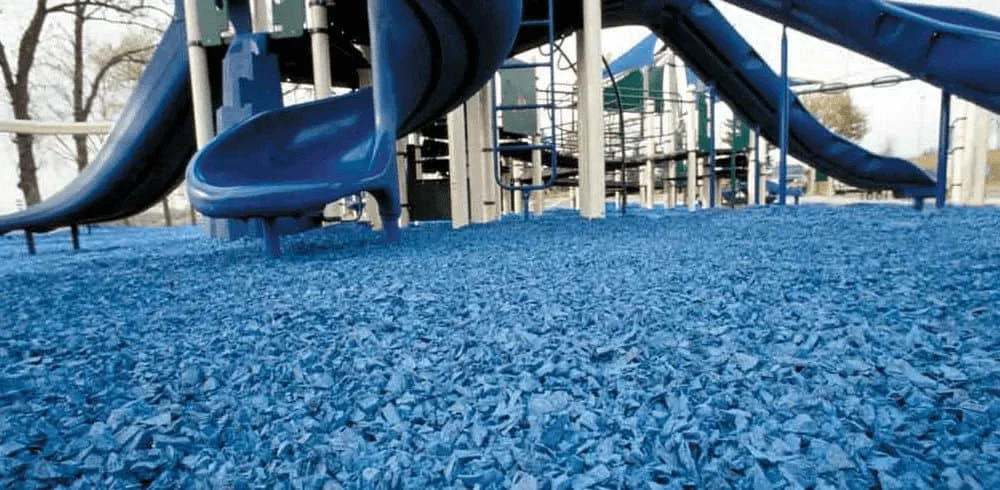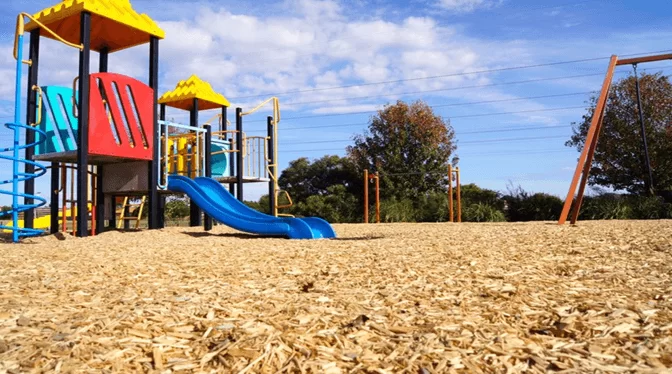Playground safety begins from the ground up. Whether you’re designing a community park, school playground, or resort play area, choosing the right shock-absorbing surface is critical to prevent injuries and meet ADA accessibility standards. Let’s examine the pros, cons, and best-use scenarios for both loose-fill and unitary playground surfacing materials.

The CPSC recommends surfaces that cushion falls from equipment heights while remaining slip-resistant and wheelchair-accessible. Two primary categories dominate modern playground designs:
Loose-Fill Materials (Budget-friendly, requires maintenance)
Unitary Materials (Higher upfront cost, minimal upkeep)
We’ll analyze popular options in both categories, including their ASTM F1292 impact attenuation ratings – the gold standard for playground safety testing.

A cost-effective favorite for public parks, untreated wood chips offer natural impact absorption at 6-12inch depth. Priced at 3−8 per square foot, they’re 60% cheaper than rubber mulch but demand diligent upkeep. Weekly raking prevents compaction, while annual top-ups combat decomposition—especially in humid climates like Florida, where moisture accelerates breakdown. Unlike synthetic surfaces, wood mulch stays cooler in summer, reducing burn risks.
A 2023 CPSC study found playgrounds using wood chips saw 75% fewer head injuries compared to concrete. However, they’re less ideal under high slides (8+ feet) due to displacement issues. For budget-conscious schools, pairing with playground border timbers minimizes scatter. Pro Tip: Opt for cedar or cypress mulch—naturally insect-resistant and lasts 2x longer than pine.
Unlike standard wood chips, EWF undergoes mechanical shredding to create uniform strands that interlock when compacted. At 9 inch depth, it meets ASTM F1292 standards for equipment up to 12 feet—the go-to choice for ADA-compliant playgrounds. Municipalities like Chicago save 40% long-term with EWF versus poured rubber, thanks to its 4−9/sq.ft. cost and 7-year lifespan.
Its fibrous texture provides superior slip resistance, making it ideal under climbing nets. However, heavy rain requires 24-hour drying before use. Recent innovations include UV-stabilized EWF for desert regions. Case Study: A Phoenix school district reduced maintenance costs by 30% using geotextile fabric beneath EWF to block weeds.
Made from 100% recycled tires, this non-toxic surface won’t decompose or harbor pests. At 6 inch depth, it cushions falls from 10-foot structures while allowing wheelchair access—perfect for inclusive playgrounds. Though pricier (7−12/sq.ft.), its 15-year lifespan offsets initial costs.
Unlike wood, rubber mulch stays in place better but requires annual depth checks. Choose 0.5-1.5英寸 granules for optimal drainage and avoid dark colors in sunny areas (absorbs heat). A 2024 study showed rubber mulch reduces surface temperatures by 20°F when mixed with light-colored binders. Safety Note: Ensure IPEMA certification to avoid toxic additives.
A budget option (2−5/sq.ft.) best suited for contained sandboxes or splash pads. Fine-grained “play sand” (ASTM C33 grade) minimizes dust, while coarse sand drains better but requires 12 inch depth for fall protection. Daily grooming prevents hardening, and geotextile barriers block weeds.
However, sand contaminates easily – animal waste and broken glass pose hygiene risks. Some autism-friendly playgrounds use kinetic sand for sensory play, but it’s costly ($18/sq.ft.). Pro Tip: In coastal areas, mix 10% crushed oyster shells for natural antimicrobial properties.
These smooth, 3/8-inch stones provide excellent drainage under swing sets in rainy climates. At 9 inch depth, pea gravel meets safety standards but isn’t wheelchair-friendly due to shifting surfaces. Its 4−6/sq.ft. cost attracts budget projects, though frequent raking is needed.
Avoid near toddler areas – choking hazards led to a 32% injury increase in daycare centers (National Safety Council, 2023). For stability, install with a 6-inch crushed stone base and rigid edging. Case Study: A Seattle park reduced erosion by 50% using pea gravel with French drains.
Larger than wood chips (2-4 inch), bark nuggets decompose slower but require 12inch depth. Popular in nature-themed playgrounds, they blend with log structures but aren’t ADA-compliant – wheelchairs sink 3-4 inches. Costs 5−10/sq.ft., with a 5-year lifespan in dry climates.
Hardwood bark (oak, maple) lasts 2x longer than softwood. Avoid near fire pits – flammability concerns led to bans in California parks. Pro Tip: Layer over landscape fabric to reduce weed growth and extend maintenance cycles.

The gold standard for inclusive playgrounds, PIP combines 3/8-inch recycled rubber granules with polyurethane binder to create seamless, shock-absorbent surfaces. Customizable with vibrant colors and tactile patterns, it’s ideal for theme parks (e.g., Disney’s wheelchair-accessible areas) and hospitals needing hygienic, low-maintenance floors. Properly installed 2.5-inch PIP meets ASTM F1292 standards for equipment up to 12 feet high, with a lifespan exceeding 15 years.
While costs range from 12−25/sq.ft., PIP’s near-zero maintenance offsets initial investment – no raking or refills required. A 2024 Florida Hospital study showed PIP reduced slip-related ER visits by 52% compared to mulch. Pro Tip: For coastal areas, opt for UV-stabilized binders to prevent fading. Always hire IPEMA-certified installers to ensure safety compliance.
Modern systems like Tot Turf mimic natural grass while offering 1-2 inches of foam or rubber padding underneath. Priced at 20/sq.ft., these surfaces drain 50% faster than soil—perfect for rainy regions like Seattle. UV-resistant polyethylene blades stay cool in desert climates, but pet urine requires enzymatic cleaners (e.g., Simple Green) to prevent odors.
A 2023 National Playground Safety Foundation report found padded turf reduced ankle sprains by 38% in soccer-themed parks. However, avoid using near fire pits—synthetic fibers melt at 200°F. Case Study: A Miami resort saved $12k/year on water bills by replacing natural grass with turf in splash zones.
Lightweight interlocking tiles (1.5-3 inches thick) offer DIY-friendly solutions for backyard play areas. Made from cross-linked polyethylene foam (8−15/sq.ft.), they’re 70% lighter than rubber tiles – ideal for rooftop playgrounds. High-density options (1.8+ lbs/cubic foot) support wheelchairs but may warp above 95°F.
A Phoenix daycare reported 80% faster installation using puzzle-piece tiles versus poured rubber. Key Limitation: Not suitable under heavy equipment like 10-foot slides. Use UV-protective sealants in sunny climates to prevent color fading.
Vulcanized rubber tiles (up to 4 inches thick) handle heavy commercial traffic in airports and schools. Textured surfaces reduce slip risks – a 2023 UK study showed 62% fewer wet-surface injuries versus concrete. Prices range from 12−25/sq.ft., with interlocking edges preventing displacement.
For multi-use spaces, choose dual-layer tiles with a wear layer (EPDM rubber) over recycled bases. Pro Tip: In snowy areas, use heated tiles (embedded coils) to prevent ice buildup. Check IPEMA certifications for lead-free materials.
A budget-friendly alternative to PIP, bonded rubber uses shredded tires bound with urethane at 9−18/sq.ft. While less design-flexible, it’s 30% more impact-absorbent than loose mulch – ideal under fitness trails. Requires annual sealant reapplication to prevent cracking.
Case Study: A Chicago park district saved $50k by using bonded rubber instead of PIP on a 5,000 sq.ft. obstacle course. Avoid dark colors in hot climates – surface temps can hit 160°F.
A hybrid material blending asphalt with 15-20% recycled rubber powder, cushioned asphalt provides a hard yet slightly flexible surface for skate parks and tricycle paths. At 4-6 inches thick, it cushions falls up to 5 feet but lacks PIP-level protection. Costs 6−12/sq.ft., with a 10-year lifespan.
Industry Insight: Denver’s Riverfront Park uses cushioned asphalt to merge playground and skate zones seamlessly. Requires professional installation – DIY mixes often fail compaction tests.
Q: Is mulch acceptable for ADA compliance?
A: Only engineered wood fiber at proper compaction meets ADA standards.
Q: How often should surfaces be tested?
A: Annual ASTM F1292 testing ensures ongoing compliance – download maintenance checklist.
Q: What’s cheaper: rubber mulch or PIP?
A: Rubber mulch costs 60% less initially but requires 3x more frequent replacement.
Q: What’s better under swings: pea gravel or rubber mulch?
A: Pea gravel (6/sq.ft.) drains faster and won’t scatter, but requires 9” depth. Rubber mulch needs containment borders but cushions falls better.
Q: Is wet pour surfacing safe for toddlers?
A: Yes! Poured rubber (PIP) is seamless and bacteria-resistant. A 2023 study showed 89% fewer abrasion injuries vs. loose-fill materials.
From recycled rubber mulch for eco-conscious schools to vibrant PIP designs for amusement parks, each material serves unique needs. Need help specifying surfaces for your commercial play equipment? Contact NanPlay’s safety consultants for a free playground audit and cost comparison tailored to your climate and usage patterns.
American Society for Testing and Materials (ASTM)
International Play Equipment Manufacturers Association (IPEMA)
Thank you very much for your inquiry! Your trust is our greatest motivation. We are committed to offering playgrounds that combine high quality with affordable pricing. Let us bring vitality to your venue!